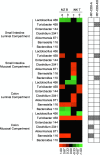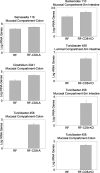Bacteria associated with immunoregulatory cells in mice
- PMID: 20008175
- PMCID: PMC2813032
- DOI: 10.1128/AEM.01561-09
Bacteria associated with immunoregulatory cells in mice
Abstract
This study examined bacteria-immune interactions in a mouse model possessing microbiota-dependent immune regulatory features similar to those occurring in human atopy, colitis, and immune regulation. Associations between the abundance of several bacterial phylotypes and immunoregulatory target cell types were identified, suggesting that they may play a role in these phenotypes.
Figures



Similar articles
-
Fecal IgA Levels and Gut Microbiota Composition Are Regulated by Invariant Natural Killer T Cells.Inflamm Bowel Dis. 2020 Apr 11;26(5):697-708. doi: 10.1093/ibd/izz300. Inflamm Bowel Dis. 2020. PMID: 31819985
-
Invariant Natural Killer T Cells Shape the Gut Microbiota and Regulate Neutrophil Recruitment and Function During Intestinal Inflammation.Front Immunol. 2018 May 7;9:999. doi: 10.3389/fimmu.2018.00999. eCollection 2018. Front Immunol. 2018. PMID: 29867976 Free PMC article.
-
Toll-Like Receptor 7 Agonist-Induced Dermatitis Causes Severe Dextran Sulfate Sodium Colitis by Altering the Gut Microbiome and Immune Cells.Cell Mol Gastroenterol Hepatol. 2018 Sep 25;7(1):135-156. doi: 10.1016/j.jcmgh.2018.09.010. eCollection 2019. Cell Mol Gastroenterol Hepatol. 2018. PMID: 30510995 Free PMC article.
-
Regulatory lymphocytes and intestinal inflammation.Annu Rev Immunol. 2009;27:313-38. doi: 10.1146/annurev.immunol.021908.132657. Annu Rev Immunol. 2009. PMID: 19302043 Review.
-
From the Deep Sea to Everywhere: Environmental Antigens for iNKT Cells.Arch Immunol Ther Exp (Warsz). 2016 Aug;64(4):291-8. doi: 10.1007/s00005-015-0381-7. Epub 2015 Dec 24. Arch Immunol Ther Exp (Warsz). 2016. PMID: 26703211 Review.
Cited by
-
Direct-fed microbial supplementation influences the bacteria community composition of the gastrointestinal tract of pre- and post-weaned calves.Sci Rep. 2018 Sep 20;8(1):14147. doi: 10.1038/s41598-018-32375-5. Sci Rep. 2018. PMID: 30237565 Free PMC article.
-
Extraction, Purification, Structural Characteristics, Biological Activities and Pharmacological Applications of Acemannan, a Polysaccharide from Aloe vera: A Review.Molecules. 2019 Apr 19;24(8):1554. doi: 10.3390/molecules24081554. Molecules. 2019. PMID: 31010204 Free PMC article. Review.
-
The Beneficial Effect of Coarse Cereals on Chronic Diseases through Regulating Gut Microbiota.Foods. 2021 Nov 22;10(11):2891. doi: 10.3390/foods10112891. Foods. 2021. PMID: 34829172 Free PMC article. Review.
-
Integrating Serum Metabolome and Gut Microbiome to Evaluate the Benefits of Lauric Acid on Lipopolysaccharide- Challenged Broilers.Front Immunol. 2021 Oct 15;12:759323. doi: 10.3389/fimmu.2021.759323. eCollection 2021. Front Immunol. 2021. PMID: 34721434 Free PMC article.
-
Carbohydrate-Free Peach (Prunus persica) and Plum (Prunus salicina) [corrected] Juice Affects Fecal Microbial Ecology in an Obese Animal Model.PLoS One. 2014 Jul 9;9(7):e101723. doi: 10.1371/journal.pone.0101723. eCollection 2014. PLoS One. 2014. PMID: 25007331 Free PMC article.
References
-
- Aranda, R., B. C. Sydora, P. L. McAllister, S. W. Binder, H. Y. Yang, S. R. Targan, and M. Kronenberg. 1997. Analysis of intestinal lymphocytes in mouse colitis mediated by transfer of CD4+, CD45RBhigh T cells to SCID recipients. J. Immunol. 158:3464-3473. - PubMed
-
- Bosshard, P. P., R. Zbinden, and M. Altwegg. 2002. Turicibacter sanguinis gen. nov., sp. nov., a novel anaerobic, Gram-positive bacterium. Int. J. Syst. Evol. Microbiol. 52:1263-1266. - PubMed
-
- Bouskra, D., C. Brézillon, M. Bérard, C. Werts, R. Varona, I. G. Boneca, and G. Eberl. 2008. Lymphoid tissue genesis induced by commensals through NOD1 regulates intestinal homeostasis. Nature 456:507-510. - PubMed
Publication types
MeSH terms
Substances
Grants and funding
LinkOut - more resources
Full Text Sources
Other Literature Sources
Molecular Biology Databases

